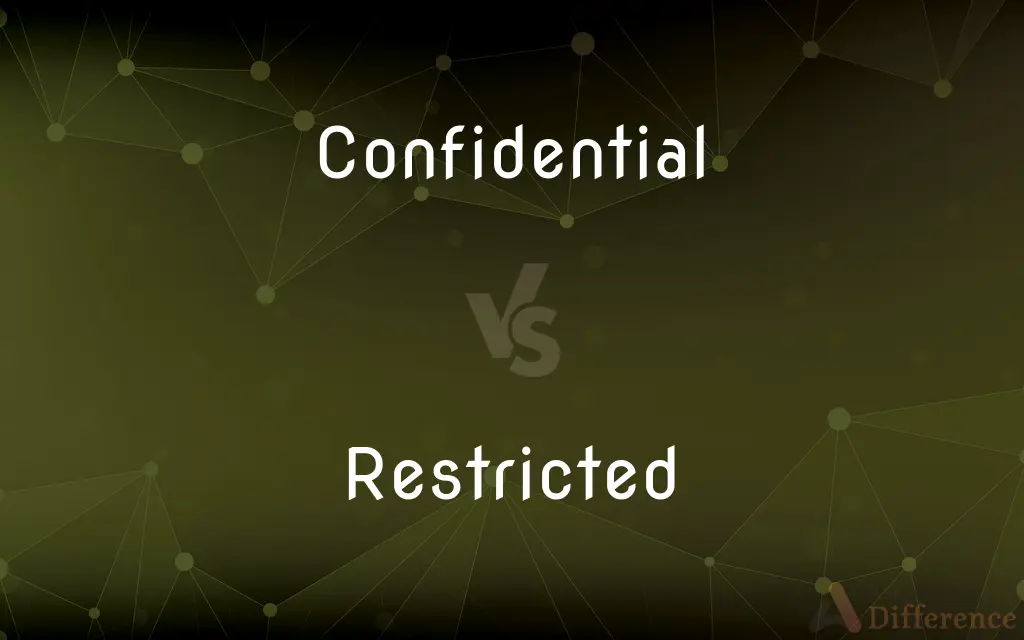Confidential vs. Restricted — What's the Difference?
Edited by Tayyaba Rehman — By Maham Liaqat — Updated on March 18, 2024
Confidential information requires safeguarding due to its sensitive nature, seen in personal or business contexts. Restricted information not only demands protection but also has limitations on who can access it, found in government or military settings.

Difference Between Confidential and Restricted
Table of Contents
ADVERTISEMENT
Key Differences
Confidential information is classified as such due to its potential to cause harm or damage if disclosed improperly. This classification often pertains to personal data, trade secrets, or business strategies that need to be protected to maintain privacy or competitive advantage. In contrast, restricted information takes the need for protection a step further by imposing specific access limitations, often governed by formal criteria or security clearances. This level of classification is common in government, military, or certain corporate contexts, where unauthorized access could compromise national security, operational security, or sensitive corporate information.
The handling of confidential information typically involves policies and procedures to prevent unauthorized disclosure, such as non-disclosure agreements or privacy policies. Restricted information, however, requires more stringent measures, including detailed access controls, security clearances, and often physical security measures to ensure that only authorized individuals can access the information. The emphasis is on both protecting the information and strictly controlling who is allowed to view or use it.
While both confidential and restricted classifications aim to protect sensitive information, the contexts in which they are applied can differ significantly. Confidential information is a broader term that can apply to various sectors, including healthcare, finance, and law. Restricted information is more likely to be associated with contexts where the stakes of unauthorized disclosure are particularly high, such as national security.
The breach of confidential information can lead to legal consequences, financial loss, and damage to reputation. For restricted information, the implications of a breach can extend further, potentially endangering public safety, national security, or critical infrastructure. The response to such breaches typically involves more severe legal and regulatory consequences.
Understanding the distinction between confidential and restricted information is crucial for individuals and organizations to implement appropriate security measures and comply with relevant laws and regulations. This knowledge ensures that sensitive information is handled responsibly, minimizing the risk of unauthorized disclosure and its potential fallout.
ADVERTISEMENT
Comparison Chart
Definition
Information that is sensitive and needs to be protected from unauthorized disclosure.
Information that is not only sensitive but also has strict access controls, often related to security clearances.
Contexts
Business, personal, legal, healthcare, etc.
Government, military, certain corporate sectors.
Access Control
Policies and procedures to prevent unauthorized access, such as NDAs.
Detailed access controls, security clearances, and sometimes physical security measures.
Potential Harm
Legal consequences, financial loss, damage to reputation.
Endangering public safety, national security, critical infrastructure.
Security Measures
Privacy policies, encryption, limited access based on need-to-know.
Highly restricted access, physical security, compartmentalization of information.
Compare with Definitions
Confidential
Confidential information must be protected due to its sensitivity.
Client records at a law firm are treated as confidential.
Restricted
Restricted information requires strict access control due to security concerns.
Military operation plans are classified as restricted information.
Confidential
Protection involves preventing unauthorized disclosure.
Employees sign NDAs to protect confidential information.
Restricted
Access is limited to individuals with specific clearances.
Only personnel with top-secret clearance can access certain restricted files.
Confidential
It often pertains to personal data or business secrets.
The recipe for a famous cola is a confidential business secret.
Restricted
Often associated with government or military contexts.
Documents detailing national security protocols are restricted.
Confidential
Breaches can lead to financial loss or damage to reputation.
The leak of confidential product designs cost the company millions.
Restricted
Breaches can endanger public safety or national security.
Unauthorized disclosure of restricted information could compromise national defense.
Confidential
Applies across various sectors like healthcare and finance.
Patient health information is considered confidential in healthcare.
Restricted
Security measures include compartmentalization and physical security.
Restricted areas are secured with biometric access controls.
Confidential
Intended to be kept secret
Confidential information
Restricted
Kept within certain limits; limited
On a restricted diet.
Confidential
Done or communicated in confidence; secret.
Restricted
Excluding or unavailable to certain groups
A restricted area.
Confidential
Entrusted with the confidence of another
A confidential secretary.
Restricted
Available only to authorized persons
A restricted file.
Confidential
Denoting confidence or intimacy
A confidential tone of voice.
Restricted
Simple past tense and past participle of restrict
Confidential
Containing information, the unauthorized disclosure of which poses a threat to national security.
Restricted
Limited within bounds.
Confidential
Kept, or meant to be kept, secret within a certain circle of persons; not intended to be known publicly
The newspaper claims a leaked confidential report by the government admits to problems with corrupt MPs.
Restricted
Available only to certain authorized groups of people.
Restricted area
Restricted access
A restricted military document
Confidential
(dated) Inclined to share confidences; (of things) making people inclined to share confidences; involving the sharing of confidences.
Sitting in front of the fire, they became quite confidential, and began to gossip.
Restricted
Only available to customers who do not belong to racial, ethnic or religious minorities.
Confidential
(dated) Having someone's confidence or trust; having a position requiring trust; worthy of being trusted with confidences.
A confidential agent; a confidential servant; a confidential whisper
Restricted
Subject to restriction or subjected to restriction;
Of restricted importance
Confidential
Enjoying, or treated with, confidence; trusted in; trustworthy; as, a confidential servant or clerk.
Restricted
Restricted in meaning; (as e.g. `man' in `a tall man')
Confidential
Communicated in confidence; secret.
Restricted
Curbed or regulated;
Controlled emotions
Confidential
Entrusted with private information and the confidence of another;
A confidential secretary
Restricted
The lowest level of official classification for documents
Confidential
(of information) given in confidence or in secret;
Closet information
This arrangement must be kept confidential
Their secret communications
Confidential
Denoting confidence or intimacy;
A confidential approach
In confidential tone of voice
Confidential
The level of official classification for documents next above restricted and below secret; available only to persons authorized to see documents so classified
Common Curiosities
How is access to restricted information controlled?
Access to restricted information is controlled through security clearances, need-to-know bases, and sometimes physical security measures to ensure that only authorized personnel can access it.
What makes information restricted?
Information is classified as restricted when it not only needs to be kept confidential but also requires stringent access controls and security clearances, often due to its potential impact on security or operations.
What are the consequences of leaking confidential vs. restricted information?
Leaking confidential information can result in legal action, financial loss, and reputational damage, while leaking restricted information can have more severe consequences, including threats to public safety, national security, and potentially legal repercussions under national security laws.
Can confidential information become restricted?
Yes, confidential information can be elevated to a restricted classification if the risk associated with its unauthorized disclosure increases or if it becomes relevant to national security or critical operations.
What constitutes confidential information?
Confidential information includes any sensitive data or knowledge that must be protected from unauthorized disclosure to prevent harm, such as personal data, trade secrets, or proprietary business information.
What role does encryption play in protecting confidential information?
Encryption plays a crucial role in protecting confidential information by converting it into a secure format that can only be accessed or deciphered by authorized individuals with the encryption key.
Can the public access restricted information under freedom of information laws?
Restricted information is typically exempt from freedom of information laws due to its sensitive nature and potential implications for security and operations.
How do data breaches involving confidential information differ from those involving restricted information?
Data breaches involving confidential information typically result in financial, legal, and reputational damage, whereas breaches involving restricted information can have broader implications, including national security risks and public safety concerns.
Are privacy policies enough to protect confidential information?
Privacy policies are a part of protecting confidential information, but they should be complemented with other security measures like encryption, access controls, and employee training to be effective.
How do organizations ensure compliance with restricted information handling?
Organizations ensure compliance through rigorous security protocols, regular audits, employee vetting, and training programs focused on the proper handling and safeguarding of restricted information.
Share Your Discovery

Previous Comparison
Comic vs. Comical
Next Comparison
Prey vs. QuarryAuthor Spotlight
Written by
Maham LiaqatEdited by
Tayyaba RehmanTayyaba Rehman is a distinguished writer, currently serving as a primary contributor to askdifference.com. As a researcher in semantics and etymology, Tayyaba's passion for the complexity of languages and their distinctions has found a perfect home on the platform. Tayyaba delves into the intricacies of language, distinguishing between commonly confused words and phrases, thereby providing clarity for readers worldwide.















































